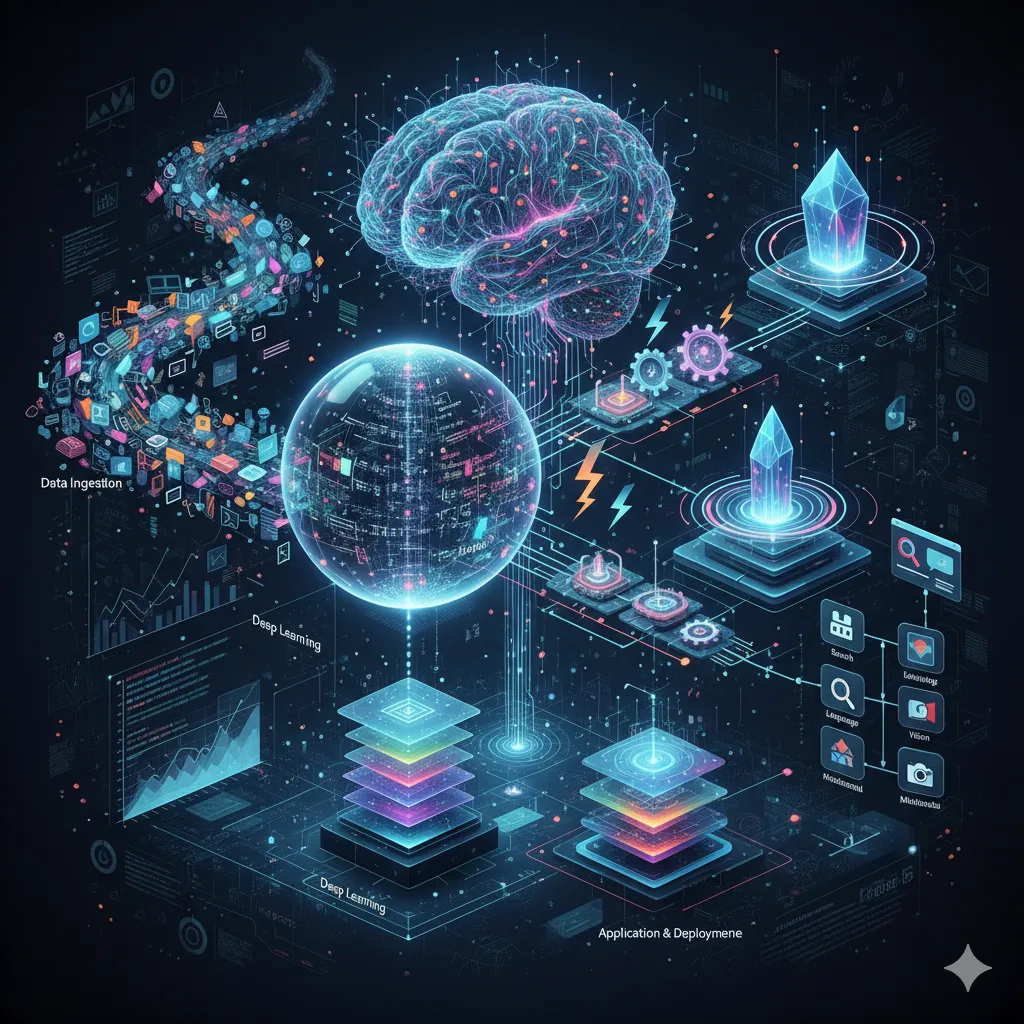How does AI work is one of the most asked questions today. In simple terms, Artificial Intelligence (AI) lets machines perform tasks that normally require human intelligence — like recognizing images, understanding language, or making predictions. This article explains the building blocks of AI, how systems learn, and how modern models such as ChatGPT and Gemini actually generate useful responses.
What Artificial Intelligence (AI) is, simply
Artificial Intelligence is a set of methods and systems that allow machines to mimic aspects of human thinking — recognizing patterns, making decisions, and improving from experience. Today’s mainstream AI is mostly “narrow” AI: systems built to do specific tasks rather than general human thinking.
Basic building blocks
Data
AI starts with data. The algorithms need examples (text, images, audio, code) to learn patterns. The more relevant and high-quality the data, the better the system can generalize.
Models
A model is a mathematical function (often a neural network) that maps inputs to outputs. Training the model means adjusting internal parameters so it produces the right output for given inputs.
Training and optimization
Artificial Intelligence Training uses algorithms (like gradient descent) to reduce errors on training examples. Over time the model’s parameters change so predictions become more accurate.
These elements — data, models, and training — together explain most of how modern AI systems are developed.
Machine learning vs deep learning
Machine learning (ML) is a broad category where models learn from data. Deep learning is a subset of ML that uses layered neural networks (many layers = “deep”) to automatically learn complex patterns from raw data like pixels or raw text. Deep learning made many modern AI breakthroughs possible because it can scale well with large datasets and computation.
How neural networks work (in plain words)
Imagine a neural network as a stack of connected layers. Each layer transforms the incoming numbers and passes results forward. During training, the network adjusts tiny numbers (weights) so that its outputs get closer to expected answers. With enough layers and data, these systems learn complicated tasks like image recognition or language generation.
Amazon Web Services, Inc.
Why transformers changed everything
The transformer architecture is the main reason large language models (LLMs) like ChatGPT exist. Transformers use a mechanism called “attention” that helps models focus on the most relevant parts of input sequences (words in a sentence, for example). This design scales well and allows models to learn relationships across long contexts, which is critical for understanding and generating coherent text.
From model to application: how modern AI systems generate answers
- Pretraining — Large models are trained on vast amounts of data to learn language structure and knowledge (this is unsupervised or self-supervised).
- Fine-tuning — Models are then adjusted on task-specific examples or with human feedback to improve safety and task accuracy.
- Serving — The trained model runs on servers; when a user asks a question, the model processes input, predicts the next tokens, and returns a natural-language answer.
This pretrain → fine-tune → serve pattern is how systems such as ChatGPT operate.
ChatGPT and similar LLMs
ChatGPT is a family of models built on the transformer idea. It was pretrained on diverse internet text and then fine-tuned with techniques like Reinforcement Learning from Human Feedback (RLHF) to make its replies more helpful and safer. When you type a prompt, ChatGPT ranks possible continuations and returns the most likely, context-coherent answer.
Gemini and multimodal models
Google’s Gemini is an example of a multimodal LLM — it can process and generate across text, images, audio, and other data types. These newer models are trained with varied datasets and architectural choices to handle multiple modalities and tasks, enabling features like explaining spreadsheets, generating images with text, or answering questions about pictures.
Key techniques behind good AI behavior
- Attention mechanisms let models weigh parts of the input differently.
- Large datasets and compute give models the breadth needed to generalize.
- Human feedback (RLHF) improves alignment and reduces harmful outputs.
Where errors come from
- Biases in data: If training data contains biased examples, models can learn and repeat those biases.
- Overgeneralization: Models sometimes make confident but incorrect statements (hallucinations) when they lack knowledge or context.
- Outdated training data: A pretrained model’s knowledge stops at the cutoff date of its training dataset unless updated or augmented.
Practical examples of AI in use
- Search and recommendations (product suggestions, video recommendations).
- Language tasks: chatbots, translation, summarization.
- Vision tasks: image classification, object detection.
- Specialized tools: code generation, data analysis assistants like Gemini in Google Sheets.
How developers build AI applications
Developers combine models with business logic and safety layers: input validation, prompt design, content filters, and post-processing. Production systems also use monitoring, logging, and human-in-the-loop checks to keep the application reliable and trustworthy.
If a business needs a public-facing interface (a website or web app) or mobile experience for an AI tool, standard product elements — UX design, APIs, hosting, and ongoing maintenance — are integrated alongside the Artificial Intelligence model.
Responsible use and safety
AI teams emphasize safety: evaluating harmful outputs, filtering personal data, and establishing guardrails. This includes testing for bias and building feedback loops where users or moderators can flag problematic outputs for improvement.
Common misconceptions
- Artificial Intelligence is not magic; it’s math and engineering.
- Most current AI is narrow, not general human-level intelligence.
Summary — the short answer to “How does AI work”
At its core, How does AI work boils down to: collect data → choose and build a model (often a neural network) → train the model on examples → fine-tune and evaluate → deploy the model with safety and monitoring. Modern LLMs like ChatGPT and multimodal models like Gemini are advanced instances of this pipeline, powered by transformer architectures, massive datasets, and specialized training steps. This is how the AI work.
Further reading (trusted sources)
IBM’s overview of AI and differences between ML, deep learning and neural networks.
Google’s official Gemini announcement and documentation.
